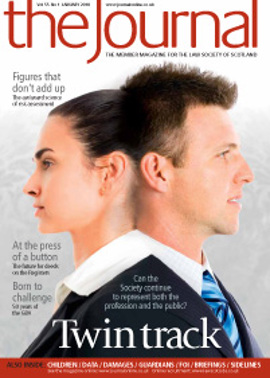Splitting from the taxman

This note covers three potential taxation pitfalls facing those who advise separating couples.
Transfers between spouses
It is well known that transfers of assets between husband and wife (or civil partners) are on a “no gain, no loss” basis. In terms of s 58 of the Taxation of Chargeable Gains Act 1992 (TCGA 92), this helpful facility remains open to spouses or civil partners during the tax year in which they separate, allowing the recipient to acquire the asset at the transferor’s base cost. The key point, however, and one which can be missed, is that the court order or contract for transfer of the asset between the parties must predate the conclusion of the tax year of separation. Or, in more complex situations, any suspensive conditions in such a minute of agreement must be purified before the end of the tax year of separation. Self-evidently, this will be an easier task when separation happens on 7 April than when it occurs on 31 March!
Principal private residence relief
A second relief available to separating spouses or civil partners relates to principal private residence relief (PPR) over the former matrimonial home. Most practitioners will be aware that PPR is generally available for a maximum of three years from the date of termination of occupation. Within the marriage or civil partnership, only one property can be treated as the sole or main residence of the parties. When an inter-spouse transfer takes place following separation, the usual 36 month relief is available (assuming the conditions in s 225B of the TCGA 92 are met). However, s 225B also extends PPR beyond the usual 36 months for separating spouses. The former matrimonial home can continue to be treated as the only or main residence of a transferring party until the earlier of (a) the date of transfer, or (b) the date upon which the recipient ceases to use the property as his or her main or only residence.
The circumstances in which s 225B becomes useful are limited by the usual restriction that relief can only be given for one property in any given period. However, it may be of particular use in protracted cases. For instance if a couple have owned a home for decades, it is likely that significant gains will be locked in the property. If the transferor has purchased another home since separation, given recent movements in the property market it is likely that the newer property will have lower gains locked in it at this stage. This may prove to be a useful planning tool, particularly in the current economic climate.
Business interests
Thirdly, heritable properties are not the only asset frequently transferred between separating parties. Interests in family businesses are also frequently so transferred. Most clients are advised of the attraction of transferring such assets within the tax year of separation. Not all such clients are advised that it may be possible to defer the tax charge, even if the agreement or judgment postdates that tax year, by applying for hold-over relief on the gift of business assets.
Two criteria must be satisfied before an application for hold-over relief will be successful.
The first is that the underlying assets themselves must qualify. Shares in trading family businesses are often eligible, but be aware that some non-trading assets, such as certain property investments, rarely qualify. The second criterion is that the recipient spouse must not give “actual consideration” for the transfer. Consideration can include the surrender of rights to financial provision, thus potentially reducing the element of gain eligible for hold-over relief. However, HM Revenue & Customs has published a specific concession (s CG67192 of the Capital Gains Tax Manual) that the recipient of such an asset does not give actual consideration where the transfer takes place as part of settlement on divorce/dissolution pursuant to a court order or an agreement formally ratified by the court. (It is believed that registration of an agreement in the Books of Council & Session would suffice.)
In short, the need to give proper consideration to the potential to avoid or defer a tax charge in these three scenarios is certainly something to which family lawyers and tax practitioners alike should be alive. A greater awareness of the taxation of separation might just put the family lawyer or tax adviser in the happy – if presently unusual – position of being the bearer of good news to a financially distressed client.
Alison Edmondson, Family Law Associate, Turcan Connell
In this issue
- Forward thinking
- Renewal of transitional guardianships
- End the navel-gazing
- Who speaks for lawyers?
- Reasons to be hopeful
- The full picture
- Hearing and speaking
- Law of unintended consequences
- More prejudicial than probative?
- One giant leap
- If the cap fits
- Half a century of strife
- From the Brussels office
- Law reform update
- Send in the SaaS
- Ask Ash
- Words and sentences
- Two in one
- Enough to turn you to drink
- Uncertain security
- Protections with legs
- Working for the estate
- Home defences
- Splitting from the taxman
- Scottish Solicitors' Discipline Tribunal
- Website review
- Book reviews
- Route to freedom
- Steady as she goes is market forecast






